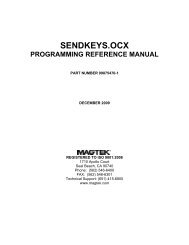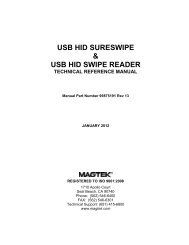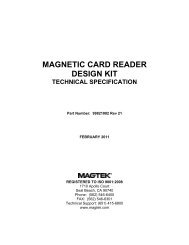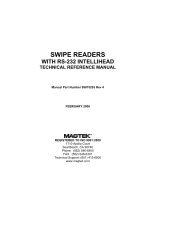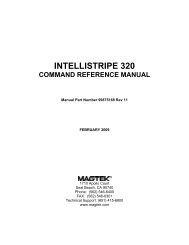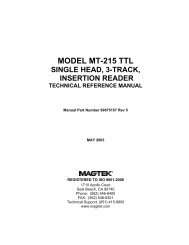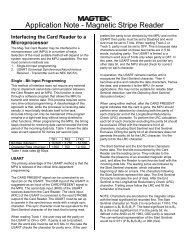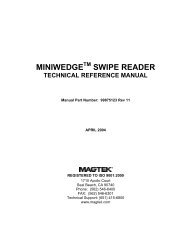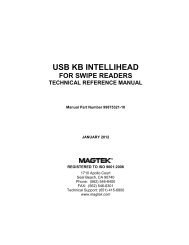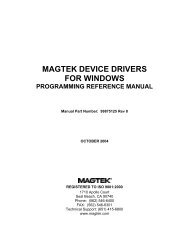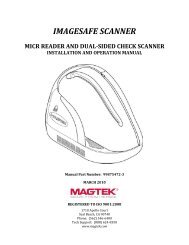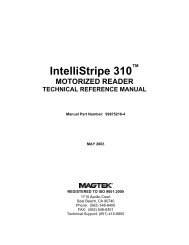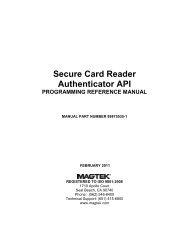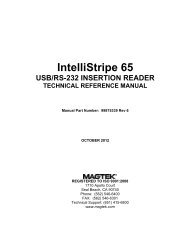I/O Interface for TTL Magnetic Stripe Readers, Technical ... - MagTek
I/O Interface for TTL Magnetic Stripe Readers, Technical ... - MagTek
I/O Interface for TTL Magnetic Stripe Readers, Technical ... - MagTek
You also want an ePaper? Increase the reach of your titles
YUMPU automatically turns print PDFs into web optimized ePapers that Google loves.
I/O <strong>Interface</strong> <strong>for</strong> <strong>TTL</strong> <strong>Magnetic</strong> <strong>Stripe</strong> <strong>Readers</strong>Calculating odd parity and LRC, <strong>for</strong> the message AT3:P 32 16 8 4 2 1 Hex Value, Decimal ValueLess Parity Less ParityStart sentinel % 1 0 0 0 1 0 1 05 hex 05 (4+1)A 1 1 0 0 0 0 1 21 hex 33 (32+1)T 0 1 1 0 1 0 0 34 hex 52 (32+16+4)3 0 0 1 0 0 1 1 13 hex 19 (16+2+1)End sentinel: ? 0 0 1 1 1 1 1 1F hex 31 (16+8+4+2+1)___________ ___ __LRC < 0 0 1 1 1 0 0 1C hex 28 (16+8+4)Calculating odd parity: scan each horizontal row and enter a zero or one In the P column so thateach row has an odd number of one's.To find the LRC: disregard the parity bits, scan up each vertical column, and make sure that eachcolumn has an even number of one's in it. Enter a zero or one in the LRC position, so that itdoes. If you are using a computer to calculate the LRC, use the "Exclusive OR" function. Next,calculate odd parity <strong>for</strong> the LRC character, in the horizontal direction.TRACKS 2 AND 3 DATA FORMATThe following is typical <strong>for</strong> Track 2 and Track 3 data.The Track 2 and 3 data <strong>for</strong>mats include the following items:1. Leading clocking zeros: Approximately 22 (Track 2) or 62 (Track 3)2. The start sentinel (hexadecimal "B")3. Up to 37 (track 2) or 104 (track 3) hexadecimal numeric characters selected by the user4. The end sentinel (hexadecimal "F")5. The LRC (longitudinal redundancy check character)6. Trailing clocking zeros: A minimum of 22 (track 2) or 62 (track 3)to the end of the cardEach data character is in a 5-bit (4 plus parity) numeric <strong>for</strong>mat. The data is in the <strong>for</strong>mat "parity,8, 4, 2, 1". Parity is odd (an odd number of one's in each character).The character is written "backwards" on the card starting with the least significant bit and endingwith the parity bit. The card data <strong>for</strong>mat Is "1, 2, 4, 8, parity".Example: The data message "123" is encoded on the card as follows:4



